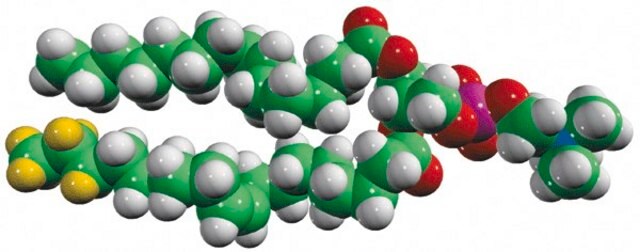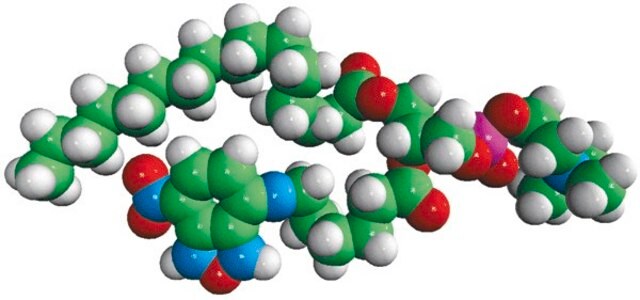Wichtige Dokumente
857228P
Avanti
C18 LPA
1-O-octadecyl-2-hydroxy-sn-glycero-3-phosphate (ammonium salt), powder
Synonym(e):
1-octadecyl-sn-glycero-3-phosphate (ammonium salt); PA(18:0e/0:0)
About This Item
Empfohlene Produkte
Assay
>99% (LPA; may contain up to 10% of the 2-LPA isomer)
Form
powder
Verpackung
pkg of 1 × 1 mg (857228P-1mg)
Hersteller/Markenname
Avanti Research™ - A Croda Brand 857228P
Lipid-Typ
phospholipids
cardiolipins
Versandbedingung
dry ice
Lagertemp.
−20°C
SMILES String
O[C@](COP([O-])(O)=O)([H])COCCCCCCCCCCCCCCCCCC.[NH4+]
InChI
1S/C21H45O6P.H3N/c1-2-3-4-5-6-7-8-9-10-11-12-13-14-15-16-17-18-26-19-21(22)20-27-28(23,24)25;/h21-22H,2-20H2,1H3,(H2,23,24,25);1H3/t21-;/m1./s1
InChIKey
FFEGYFZPOUEMED-ZMBIFBSDSA-N
Allgemeine Beschreibung
Anwendung
- to study its effects on Yes-associated protein (YAP) phosphorylation
- as a standard for the quantification of lysophosphatidic acid (LPA) compounds in proton samples using reversed-phase ultra-performance liquid chromatography-tandem mass spectrometer (UPLC-MS/MS)
- as a substrate to investigate the phosphatase activity of soluble epoxide hydrolase (sEH) towards LPA compounds
Biochem./physiol. Wirkung
Verpackung
Rechtliche Hinweise
Lagerklassenschlüssel
11 - Combustible Solids
WGK
WGK 3
Hier finden Sie alle aktuellen Versionen:
Analysenzertifikate (COA)
It looks like we've run into a problem, but you can still download Certificates of Analysis from our Dokumente section.
Wenn Sie Hilfe benötigen, wenden Sie sich bitte an Kundensupport
Besitzen Sie dieses Produkt bereits?
In der Dokumentenbibliothek finden Sie die Dokumentation zu den Produkten, die Sie kürzlich erworben haben.
Unser Team von Wissenschaftlern verfügt über Erfahrung in allen Forschungsbereichen einschließlich Life Science, Materialwissenschaften, chemischer Synthese, Chromatographie, Analytik und vielen mehr..
Setzen Sie sich mit dem technischen Dienst in Verbindung.








